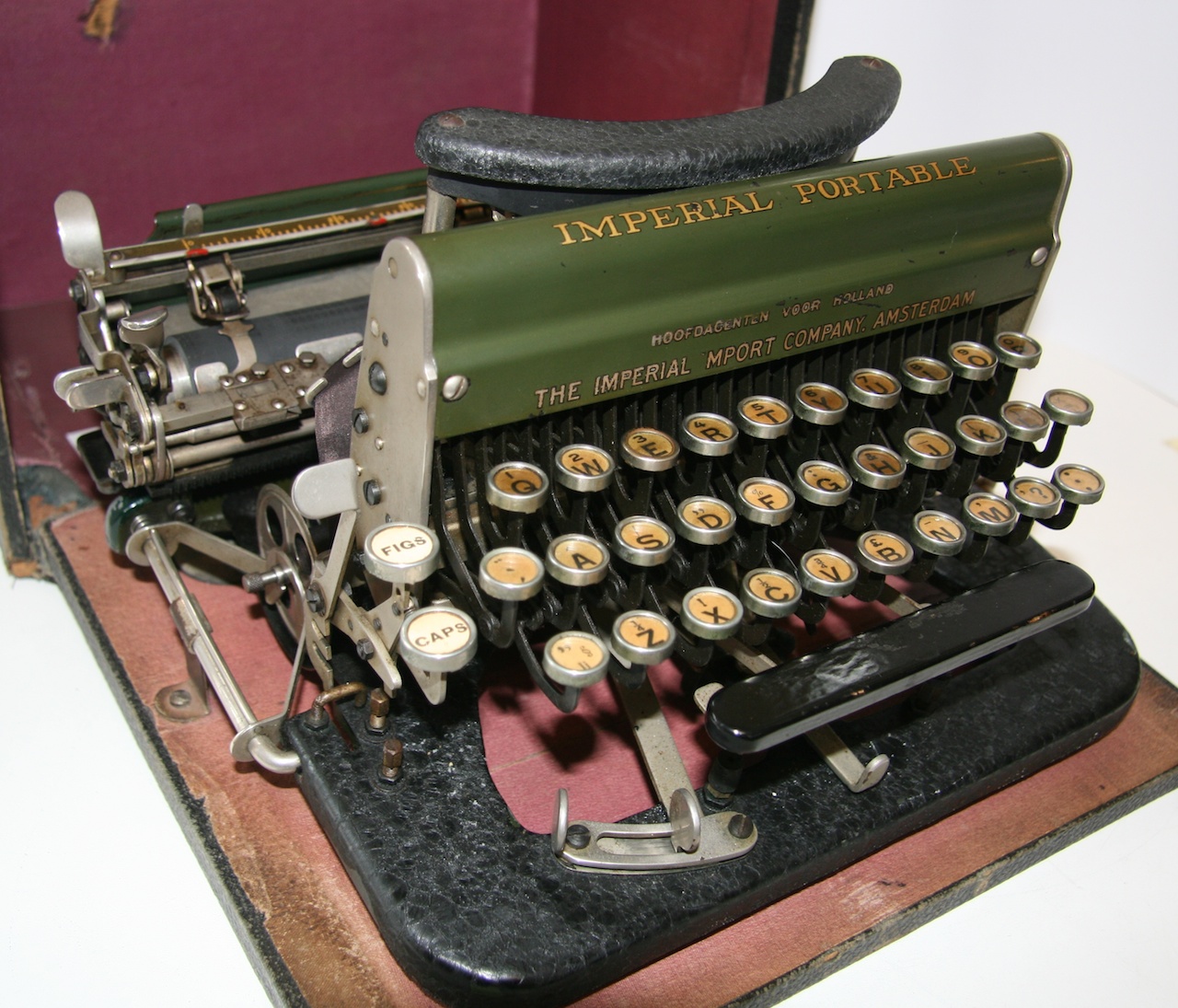- Fleetwing
- Typewriter Talk Vet
 Offline
Offline - From: Hartford, CT USA
- Registered: 30-6-2015
- Posts: 1,022
Re: Wide ribbon?
See FAQ #1 for possible sources of nonstandard ribbon sizes: I hear good things about Baco, and it sounds like the sort of business worth supporting.
I had not thought of glycerin, so that's a good tip indeed. It's harder to apply it with solid (i.e. not "spoked") spools, though. The other trick I've heard of is to unspool the ribbon and spray WD40 on and let it soak in (not sure how long), and then respool it. Supposedly it'll bring a ribbon back to life, though not yield a fully black result.
- Repartee
- Key Master
 Offline
Offline 
- From: Brooklyn
- Registered: 12-10-2015
- Posts: 683
Re: Wide ribbon?
Uwe wrote:
...Here are a few anecdotal descriptions of the ribbon revival process.
In 1994 Louise Milano of Des Plaines, Illinois claimed that she had been using the same typewriter ribbon since 1957. There are crucial details missing, such as how much she actually used that same ribbon over those 37 years, or how often she had to revitalize it, but here’s her shared technique:“Hand roll all of the ribbon on one spool. Take a can of 3-in-1 Oil and oil drop by drop all around the ribbon. Wrap the ribbon in plastic cling wrap and let it sit for a couple of days. You'll be surprised at how much black is left on the ribbon."
I conjecture the effectiveness of these techniques arises from lowering the viscosity of the ink to the point where it can migrate around the ribbon: if the ink cannot migrate then even using the three band technique (top, center and flip) there will be a significant area of ribbon with no impacts and no ink use.
I remember a discussion prompted by some old typing tips (a film short?) whether it really achieved anything to allow a ribbon to "rest". Some said it was poppycock, and the question did come up why bicolor ribbons did not bleed into each other, but I suppose it would depend on the fabric and particular formulation of the ink - if the ink is wet enough to move a significant distance by capillary action in a reasonable time then it makes sense. Some ribbons would presumably have been wetter than others.
I have had bicolor ribbons bleed into each other, but that was after heavy use: these were NOS ribbons IIRC and PARTYNOW (not a real abbreviation), and apparently siting in the box for several decades had not encouraged the ink to move around much, but after typing back and forth over the black band a number of times red letters would no longer type clean red but red and black: you could see the ink migration on the ribbon. Vibration induced liquefaction - it's not just for earthquakes anymore!
"Damn the torpedoes! Four bells, Captain Drayton".
- Uwe
- Moderator
 Offline
Offline 
- From: Toronto, Canada
- Registered: 12-3-2013
- Posts: 4,410
Re: Wide ribbon?
I'm too lazy to quote the previous three posts, so this might all seem very random:
I would never use WD-40 on a ribbon, and I'm not sure why some people are hell bent on using that product on everything from rusty parts to their pancakes. I don't know if it's true, but apparently WD stands for water displacement, which is supposed to be the one true forte of the product.
I've placed a few orders for bulk ribbon from Baco and doubt that I ever will again. I did not find them great to deal with; however, your results and mileage may vary.
As for the sudden urge of a NOS ribbon's black portion to migrate south for the winter, it's something I've never experienced, and I've used shoeboxes full of the stuff. It almost sounds like the ribbon was coming in contact with something on the machine that might have been oiled or had some other chemical applied to it, which would explain why the blank ink would suddenly bleed, something that no unmolested ribbon should ever do. Just an idea - tossing it out there - and if it sticks, well...
The pronoun I has always been capitalized in the English language for more than 700 years.
- Repartee
- Key Master
 Offline
Offline 
- From: Brooklyn
- Registered: 12-10-2015
- Posts: 683
Re: Wide ribbon?
Uwe wrote:
I don't know if it's true, but apparently WD stands for water displacement, which is supposed to be the one true forte of the product
I don't know if it's true either, so you have either cleared up one of life's enduring mysteries or added another folk etymology to the fire. According to Wikipedia:
WD-40 was developed in 1953 by Norman Larsen,[2] founder of the Rocket Chemical Company, in San Diego, California. 'WD-40' is abbreviated from the term 'Water Displacement, 40th formula', suggesting it was the result of Larsen's 40th attempt to create the product."
Which suggests that either the name was some internal designation not originally intended for marketing which leaked and stuck or that this story is yet more marketing malarkey to explain the supposed origin of a name itself created by marketing by measuring galvanic skin potential of subjects as they listened to a long list of nonsense trade names. They were Mad Men. And they were effective.
It has been noted that you have a profound and lasting aversion to this product
"Damn the torpedoes! Four bells, Captain Drayton".
- Bassoonbloke
- Platen Punisher
 Offline
Offline 
- From: South East London. UK
- Registered: 15-4-2014
- Posts: 57
Re: Wide ribbon?
Hello there,
Have a look at the bottom of this page for wider ribbons.
I brought one of the 1" ribbons to go on my Remington 7. It isn't quite wide enough, but if you make a spacer to fill in the gap it will work on the original spools (it can get very messy trying to get is sorted out, so wear plastic gloves !!).
Good Luck with it.
Alan.
- Rushwarp
- Novice Typer
 Offline
Offline - Registered: 06-10-2016
- Posts: 41
Re: Wide ribbon?
Thanks Alan, much obliged.
(By the way I just acquired a black Imperial like your avatar picture!)
Cheers
Rushwarp
- •
- Repartee
- Key Master
 Offline
Offline 
- From: Brooklyn
- Registered: 12-10-2015
- Posts: 683
Re: Wide ribbon?
Fleetwing wrote:
I had not thought of glycerin, so that's a good tip indeed. It's harder to apply it with solid (i.e. not "spoked") spools, though. The other trick I've heard of is to unspool the ribbon and spray WD40 on and let it soak in (not sure how long), and then respool it. Supposedly it'll bring a ribbon back to life, though not yield a fully black result.
I just completed the experiment and it worked well. I used a standard 1/2" Remington ribbon which was well exhausted along the typing tracks and yielding faint impressions. I did not see any need for the messy unspooling and respooling since the lack of flanges is going to help evenly distribute the solvent. I used a heavy gauge sealable plastic bag just a little larger than the spooled ribbon and sprayed in WD-40 =8^{ ) in small doses as long as the ribbon absorbed it, let the ribbon rest several days wetted with the evil liquid, and finally exposed it to air for several more days to allow the volatile fractions to evaporate.
I am sorry for those who have seen spreading stains of WD-40 on the walls of cursed rooms where oily murders were made, but it worked great! A little uneven but far from looking exhausted, and I only regret that I had already tossed several Remington ribbons that could have been made into perfectly good leftovers, like my mother would have told me. Sorry mom.
"Damn the torpedoes! Four bells, Captain Drayton".


